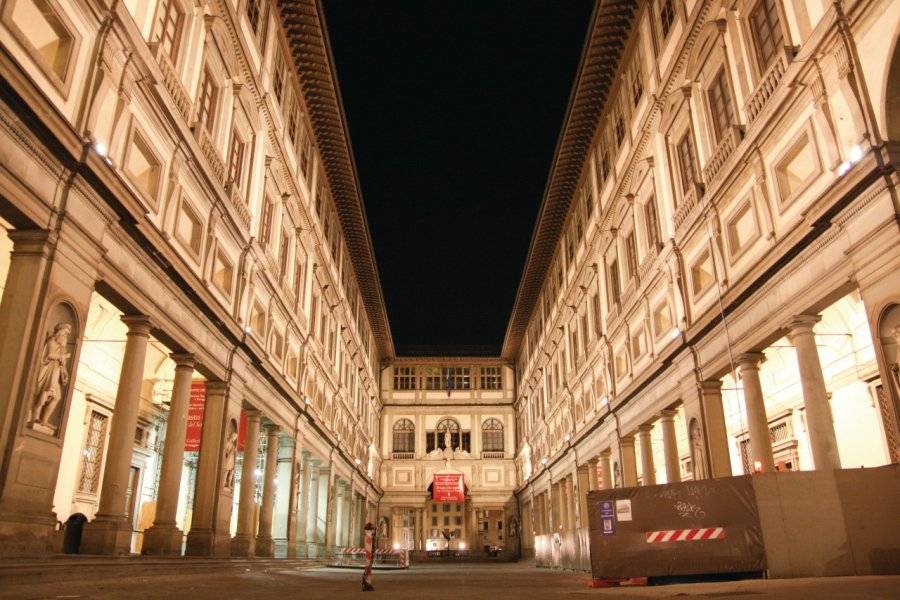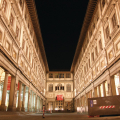GALLERIA DEGLI UFFIZI
A priceless artistic heritage, the Uffizi Gallery is one of the most visited and prestigious museums in the world.
The Uffizi Gallery is one of the most popular and prestigious museums in the world. It houses a magnificent collection of artworks originating with the Medici family, and enriched over the centuries by bequests, exchanges and other donations. Open to the public since 1765, the museum continues to showcase the greatest masterpieces of the Renaissance. A priceless artistic heritage!
The Uffizi Palace, designed by Vasari for Cosimo I de' Medici in 1560, takes its name from its original purpose: the administration of the city of Florence(Uffizi). Only a handful of museums in the world can offer such extensive and comprehensive collections. Works are displayed in chronological order. Here's how the rooms were laid out during our visit (it's best to bring a floor plan with you as the layout of the rooms changes frequently):
The second floor is devoted to the cabinet of drawings and prints from the late 14th to the 20th century, housed in the refurbished spaces of the former Medici theater.
Room 1 presents Cosimo I's collection of antiquities. Starting with early Byzantine artists such as Cimabue and Duccio di Buoninsegna, the museum illustrates the evolution of the history of painting, from the masterpieces of Giotto and other minor artists from Florence and Siena, to the extraordinary Adoration of the Magi by Gentile da Fabriano. This painting, dating from 1423, plunges us into the refined atmosphere of the International Gothic period, with its elegant gilding and fairytale setting of the biblical episode.
The collection continues with Renaissance paintings by artists such as Masaccio, Paolo Uccello, Filippo Lippi and Piero della Francesca. Special attention is devoted to Botticelli, whose world-renowned paintings The Birth of Venus and Spring. Painted around 1486, The Birth of Venus depicts the goddess of beauty on a scallop shell resting on the waves stirred by Zephyr's breath. The work symbolizes the transmission of beauty from the divine order to the mortal world. As for Spring, a painting on wood panel painted around 1478, it illustrates a poem by Politian dedicated to the reign of Venus. This painting is the object of a cult similar to that of the Mona Lisa, considered one of the most beautiful paintings in the world.
The 16th century is represented by Michelangelo, Leonardo da Vinci, Raphael, the Tuscan painters of the Mannerist style (such as Pontormo) and the Venetian school with the immortal works of Titian, Tintoretto and Veronese.
On the second floor, the loggia niches added in the 19th century house marble sculptures of eminent Florentines and Tuscans (Dante, Lorenzo the Magnificent, Leonardo da Vinci, Galileo Galilei...). Take time to admire the grotesque ceilings attributed to Alessandro Allori (1535-1607) and trompe-l'œil.
Rooms 2 and 3 focus on Italian painting of the 13th and 14th centuries, with masterpieces by Cimabue, Duccio and Giotto, including the Madonna trilogy, which illustrates the transition made by the Tuscan Primitives from the Italo-Byzantine style to a typically Italian style.
Room 7, known as Primo Rinascimento, features works by Masaccio(Sant'Anna Metterza), Fra Angelico, known as Beato Angelico in Italy(The Coronation of the Virgin), Piero della Francesca, master of perspective, and Paolo Uccello(The Battle of San Romano).
Room 8 is dedicated to Filippo Lippi (1406-1469), an artist as famous as he was sought-after in his day. His painting is renowned for its delicacy and luminosity. He was Botticelli's master, to whom he passed on the subtle polychromy of his paintings and the elegance of his silhouettes.
Rooms 10 to 14 feature paintings from Botticelli's youth, including the little-known but fascinating Calumny of Apelles, a small painting on wood whose allegorical subject is slander.
Room 15 presents early works by Leonardo da Vinci, in which the influence of his masters can be felt: The Annunciation, and the mystical, enigmatic (and recently restored) Adoration of the Magi. This famous painting of the birth of Christ, commissioned by the convent of San Donato in Scopeto in 1481, was Leonardo's first major commission. It remained unfinished when the artist left for Milan.
Room 16, commissioned by Ferdinand I, Grand Duke of Tuscany between 1587 and 1609, is decorated with maps of the Florentine territory.
The Tribuna (room 18), created for Francis I in 1584 to a design by Buontalenti, features Bronzino's magnificent portrait of Lucrezia Panciatichi, Vasari's portrait of Lorenzo de' Medici, and the Medici Venus, a 4th-century BC Roman copy that was one of Napoleon's "loans".
Room 23: Correggio, considered one of the most daring artists of the Italian High Renaissance, and Andrea Mantegna, gifted with an exceptional gift for painting and much appreciated by the aristocracy and the Catholic Church, the great patrons of the period.
Room 25: Michelangelo's Tondo Doni, a famous round painting created in 1506 depicting the Holy Family. Note the twisting of the Virgin's body, giving an impression of movement.
Room 26: Raphael and Andrea del Sarto. A painter of harmony and grace, Raffaello Sanzio, better known as Raphael (1483-1520), was considered by his contemporaries to be almost divine. The Florentine painter Andrea del Sarto (1486-1530), for his part, developed a poetic, expressive art of rich color, heralding the arrival of Mannerism.
In room 28, the Florentine chromatic influence can be seen in Titian's Venetian works, crowned by The Venus of Urbino. This oil on canvas (1538) embodies the matrix of the erotic female nude, from which Édouard Manet drew inspiration 325 years later for his Olympia.
Room 32, dedicated to Venetian painting of the second half of the 16th century, focuses on Jacopo Robusti, known as Tintoretto. His portrait Leda and the Swan (1555) was originally in Paris as part of the Duc d'Orléans collection.
Room 38, known as the Hermaphrodite Room, features a Roman copy of a Hellenistic original from the 2nd century BC, depicting the life-size son of Hermes and Aphrodite.
Room 45: 15th-century Venetian, Umbrian, Flemish and German painting. Masterpieces by Andrea Mantegna include The Madonna of the Quarry (1489). There are also works by Albrecht Dürer (1471-1528), a German painter and draughtsman of genius, such as The Portrait of the Father.
Room 48: 17th-century French painters on sacred themes. Charles Le Brun (decorator of Versailles and Vaux-le-Vicomte), Jacques Stella (a painter from Lyon who spent time in Italy, and whose career was rich in commissions) and Simon Vouet (the most important Parisian painter in the reign of Louis XIII).
Room 58 features Andrea del Sarto (1486-1530). Dubbed "the painter without errors" by Vasari, del Sarto was the master of the first generation of so-called "eccentric" artists. Among the paintings of major interest is The Madonna of the Harpies (1517), a solemn altarpiece featuring an unusual depiction of the Virgin Mary.
Room 60: Giovanni Battista di Jacopo (1495-1540), known as Rosso Fiorentino. The Moses Defending the Daughters of Jethro is one of the outstanding works by this Florentine artist.
Room 66 is dedicated to one of the world's best-known Italian artists, Raphael. Important works in the painter's artistic career are presented here, such as The Madonna of the Goldfinch, dating from 1506. Seated on a rock, the Virgin interrupts her reading to look tenderly at two children, her son Jesus and Saint John. In the center of the painting, a goldfinch symbolizes the King of Heaven.
In conclusion, the art of the 14th century and the Renaissance is preciously preserved in this museum, one of the most famous in the world, which welcomes almost two million visitors every year. To facilitate your visit, we strongly advise you to book online. Tickets can be collected ten minutes before your scheduled visit, at Gate 3.
Did you know? This review was written by our professional authors.
Members' reviews on GALLERIA DEGLI UFFIZI
The ratings and reviews below reflect the subjective opinions of members and not the opinion of The Little Witty.









